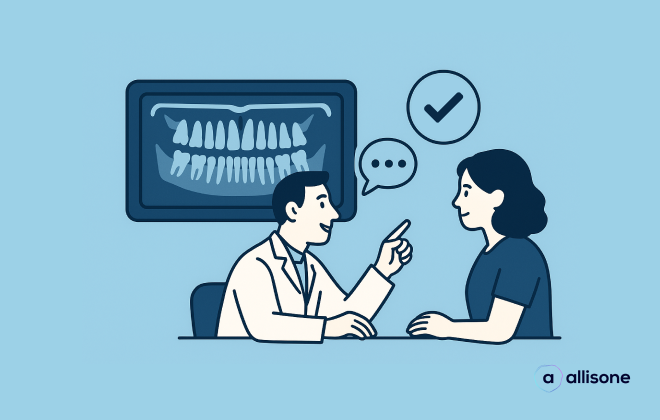
Today, informed consent is a matter of course in modern dental practice. But how did this notion come about, and how can we ensure that it is respected?
Far from being a mere administrative formality, it forms the basis of a relationship of trust between practitioner and patient. By fully informing the patient of the various treatment options, the risks involved and the associated costs, the dental surgeon not only complies with a legal framework, but also adopts an ethical stance. In an increasingly regulated healthcare environment, the obligation to provide information, reinforced by the law of March 4, 2002, represents a lever for transparency that aims to empower the patient and prevent misunderstandings. Today, informed consent has become a guarantee of quality care and protection for both patient and practitioner.
Informed consent: its foundations and evolution in the patient-practitioner relationship
The evolution of informed consent in the patient-practitioner relationship
The relationship between practitioner and patient has undergone a profound transformation in recent decades. Once marked by a form of medical paternalism, this relationship was based on the patient's blind trust in his or her doctor, with minimal information passed on. The dental surgeon, as the holder of knowledge and expertise, was given full responsibility for medical decisions. This approach has given way to a more balanced dynamic, in which the patient, better informed and more involved, wishes to play an active part in his or her therapeutic choices.
This transformation of the patient-practitioner relationship is reinforced by technological advances and access to information via the Internet. Patients often come to the dental practice with high expectations, fuelled by prior research, and ask more specific questions about treatments and their alternatives. It's up to the practitioner to provide precise, didactic answers, while maintaining an empathetic approach to prevent information from becoming a source of anxiety or misunderstanding. It is in this climate of transparency that the care contract is forged, creating a new balance in the care relationship.
The foundations of informed consent
Informed consent rests on two essential pillars: the patient's freedom to choose or refuse treatment, and the practitioner's obligation to provide all the information necessary for the patient to make an informed decision. This process reinforces the patient's autonomy, while providing a protective legal framework for the practitioner. From now on, the relationship of trust is established not only on the perceived competence of the professional, but on the transparency and communication that take place around the proposed care. In fact, informed consent is not just an administrative act, but an ethical process in which the patient becomes a player in his or her own health.
Consent is not a fixed act. Patients retain the right to withdraw their consent at any time, depending on changes in their state of health or their personal assessment of the risks involved. This means that even after agreeing to treatment, the patient can reverse his or her decision. As a practitioner, it is vital to respect this right and to accompany the patient on his or her journey, re-informing them of the consequences of their choice. This is an essential aspect of the relationship of trust that must prevail between patient and dentist.
The evolving legislative framework for informed consent in dentistry
Developments in case law and the liability of dental practitioners
The Hédreul ruling in 1997 marked a key moment in the evolution of informed consent. This Court of Cassation ruling introduced what is known as the "reversal of the burden of proof". Prior to this ruling, it was up to the patient to prove that he or she had not been properly informed. Since then, the onus has shifted to the practitioner to prove that the patient was properly informed. This evolution has reinforced the need for practitioners to record tangible evidence of the information given in the medical file, such as estimates, explanatory sheets or written exchanges.
March 4, 2002: a turning point for patients' rights and the obligation to provide information
One of the founding texts of patient rights in France is the law of March 4, 2002, also known as the Kouchner law. This text marked a decisive turning point in the way healthcare professionals, including dentists, must approach their relationship with patients. This law introduced the obligation to fully inform the patient before any medical or dental intervention, and enshrined this requirement in the French Public Health Code. Under this law, no treatment can be carried out without the patient's consent, after having been fully informed not only of the medical acts envisaged, but also of the potential risks, therapeutic alternatives and possible consequences of refusing treatment. Failure to comply with this obligation exposes the practitioner to legal action in the event of a dispute.
The dental surgeon's legal obligations regarding information and consent
What should the information contain?
Article L.1111-2 of the French Public Health Code states that the practitioner is obliged to inform the patient about his or her state of health and the care envisaged. Diagnosis is the first step in this process. It enables the practitioner to lay a solid foundation of information by clearly explaining the patient's dental condition and the interventions required. Once the diagnosis has been made, the dental surgeon must explain the various treatment options, their usefulness and the expected results. This information must also include the risks inherent in each procedure, whether frequent or exceptional, in order to respect the patient's right to full information.
Information, however, is not limited to the pre-treatment phase. The dental surgeon must also keep his patient informed throughout the treatment, particularly in the event of changes to the initial plan, the emergence of new risks, or the need for re-operation. This also includes the obligation to provide post-treatment information, should new risks or complications arise. These different stages enable patients to maintain informed consent throughout their treatment, reinforcing mutual trust in the care relationship.
The dental surgeon must also communicate the cost of the proposed treatment, detailing each stage of treatment in an estimate. This estimate, signed by both parties, forms an integral part of the information and guarantees the financial transparency of the treatment. It is essential that the patient also understands the possible alternatives, both medically and financially. Our Allisone.ai software facilitates this communication, enabling patients to better visualize the care options available to them. If the patient has other treatment options, the practitioner must present them, detailing the advantages and disadvantages of each.
The importance of complete, comprehensible information
It is essential to distinguish between minor and major risks during the information phase. Minor risks, such as mild post-operative pain or temporary discomfort, do not require as detailed information as major risks. Serious risks, on the other hand, even if they are exceptional, must be explained in detail, in accordance with article L.1111-2 of the French Public Health Code. For example, in the case of surgery involving complex tooth extraction, the patient must be warned of possible complications, such as infections or nerve damage.
Information must be adapted to the patient's ability to understand. This implies communication adapted to the patient's capacity for discernment, taking into account their age, level of education and any apprehensions they may have. It is up to the dental surgeon to use simple terms, or even visual simulations on our Allisone.ai software, to ensure that the patient fully understands the ins and outs of the treatment. The use of technology such as Allisone with its illustrated treatments and explanatory sheets can prove useful, and can always be adapted to the patient's particular situation.
Legal challenges and issues for the practitioner
Penalties for lack of information or vitiated consent
Failure to comply with the duty to inform exposes the dental surgeon to civil, criminal and ethical sanctions. Since the Cour de cassation's Hédreul ruling in 1997, the burden of proof has been on the practitioner to demonstrate that he has properly informed the patient of the risks associated with the treatment. This jurisprudence was reinforced by the March 4, 2002 law on patients' rights, which enshrined in the Public Health Code the practitioner's obligation to prove that he has respected his duty to inform. ****
Failure to provide information can be invoked by the patient to obtain compensation. A patient who has been misinformed may claim to have lost the chance to avoid the complications that have arisen, which is referred to as "loss of chance". Recent case law, notably the June 3, 2010 ruling by the French Supreme Court (Cour de cassation), has introduced the notion of "moral prejudice" in cases of failure to provide information. This damage results from the patient's unpreparedness in the face of an unmentioned risk, and may be compensated independently of the bodily injury.
In certain cases, such as cosmetic procedures or complex surgical interventions, the absence of informed consent may also render the practitioner criminally liable. Criminal proceedings may be instituted when the injury to the patient's physical integrity results from an absence of medical necessity, underlining the vital importance of clear, detailed information.
Finally, in terms of ethical responsibility, the dental surgeon must ensure that consent is obtained under the best possible conditions, by making sure that the patient has fully understood the issues, risks and benefits of the proposed procedure. According to the Code of Ethics for Dentists, any omission or inaccuracy in the information given to the patient may incur the practitioner's disciplinary liability, which may be sanctioned by the Order.
Proof of consent
Faced with the obligation to prove that the patient has been properly informed, practitioners have a number of means at their disposal to protect themselves. The most common is the use of a "bundle of presumptions", i.e. the accumulation of evidence to demonstrate that the information was indeed provided. Such evidence includes notes in the medical file, the estimate signed by the patient, and standardized information documents handed out prior to treatment.
The information given must not only be oral, but also recorded in writing in the patient's medical file. The detailed estimate is the first proof that information on the cost and content of treatment has been provided. It must include a precise description of the procedures to be carried out, the equipment to be used, the timeframe and the overall cost of the treatment. According to article L.1111-3 of the French Public Health Code, any non-reimbursed services must be clearly mentioned, as well as less expensive alternatives if they exist.
A written document, such as an informed consent form, is a frequently used method of formalizing this information. This form should detail the procedures envisaged, the potential risks, and the alternatives available. It is recommended for complex or costly procedures, such as implant treatments, difficult surgical extractions or the fitting of major prostheses. Written consent enables the practitioner to protect himself in the event of a dispute, proving that the patient has been informed and has given his consent.
Medical follow-up is also a key element in ensuring traceability of the information and consent process. Keeping up to date with exchanges with the patient, particularly when the treatment plan is modified, is essential. It is advisable to record all steps in the medical record, to keep proof of communication (letters, e-mails) and to use multimedia tools to illustrate the explanations given, such as Allisone.ai.
The role of consent in preventing dental care-related disputes and litigation
Respect for informed consent is one of the best tools for preventing disputes. By communicating clearly and transparently, dentists establish a relationship of trust with their patients. This relationship is often the determining factor in the amicable resolution of disputes. Indeed, disputes frequently arise from a lack of understanding on the part of the patient as to the procedures performed, or the results obtained in relation to expectations.
Good communication about the risks and limitations of dental procedures enables the patient to have realistic expectations, thus reducing the likelihood of post-treatment dissatisfaction. Informed consent, as an interactive and dynamic process, thus helps to defuse tensions before they turn into disputes.
Informed consent is not only a legal requirement, it is also a fundamental principle of medical ethics and deontology. By clearly informing patients of the issues at stake, the risks involved and the treatment alternatives on offer, dentists are able to establish a relationship of trust that is essential to calm, high-quality care. This means not only respecting patients' rights, but also protecting against the legal risks associated with misunderstanding or lack of information.
Allisone.ai makes everyday life easier for practitioners, by considerably improving communication. Our software helps you to collect informed consent - which has become essential - and to scrupulously respect the information process, in order to prevent litigation in the face of increasingly strict legislation.
Articles en lien
Lorem ipsum dolor sit amet, consectetur adipiscing elit.

L’intelligence artificielle au cœur des soins dentaires : témoignage du Dr Paola

Mieux faire accepter les plans de traitement : 4 leviers qui fonctionnent vraiment






